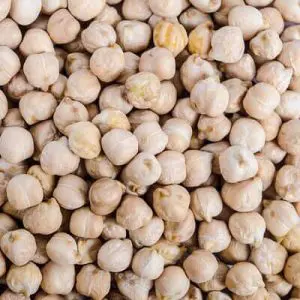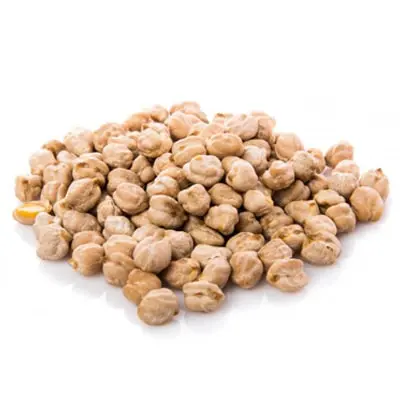The seemingly ubiquitous chickpea (Cicer arietinum) can be found just about anywhere – on grocery shelves in cans, dried in bulk bins at health food stores or markets, and on menus from across the globe in a stunning variety of preparations: roasted snacks, boiled and made into humus, ground into flour, shaped into balls for falafel, fermented to make a drink similar to sake, thrown into hearty stews or sprinkled on top of salads.
A member of the legume family, it is believed the that the chickpea was one of the earliest cultivated vegetables. Remains of chickpeas dating from the Neolithic period have been found in Turkey and throughout the Mediterranean. Mesolithic layers in a cave in France have produced carbon dated evidence of their presence as far back as 6790 BC. Charlemagne speaks of them in his Capitulare de villis (circa 800 AD). The name ‘chickpea’ is from the French chiche, which in turn was from cicer, Latin for chickpea! It gives on pause to consider that the Roman name Cicero was taken directly from their word for chickpea.
We also know this mighty bean by the name garbanzo, which comes from the Old Spanish arvanco which then arrived into the English language as garvance. The current form garbanzo is directly out of modern Spanish, and we see that reflected anywhere in the United States where there is the least bit of Spanish or Mexican influence.

This infinitely useful bean is a real nutritional workhorse. The chickpea’s high insoluble fiber content helps to lower cholesterol as well as guard against digestive problems such as diverticulosis and irritable bowel syndrome. The high fiber content also prevents blood sugar levels from rising too quickly after meals. At 49 to 53 mg dietary calcium per 100 grams, chickpeas match yogurt as a valuable source of calcium. Chickpeas are essential in low, or non-meat diets, having an average of 15 grams of protein per cup of cooked beans, and containing high levels of iron, zinc, folate, phosphorus, and B vitamins.
As noted earlier, chickpeas can be found in just about any form one could possibly want: pre-cooked, canned, frozen and dried. Although we tend to prefer preparing foods ourselves from scratch, the good news is that chickpeas do not lose any of their nutritional value when canned and pre-cooked. So, whether one has the time to soak them over night before cooking them, or wants to save precious time by using canned, there need not be any worry about losing any of the benefits.
Better yet, in our constant pursuit of the perfect snack that doesn’t involve GMO’s or gluten, we have many choices of chickpeas transformed into healthy puffs, crunchy crispies, crackers, and chips, flavored with everything from vinegar to sea salt, to cheese, and cool ranch!
Lastly, one of the most interesting recent developments in food-hacking involves the newly-named ‘aquafaba’ – literally, bean water. It was discovered that the water in which you soak and then cook your beans, or even the water straight out of the can of chickpeas, makes a perfect replacement for egg whites. Vegans everywhere are delighted with the results they get making delicious meringues, macaroons, fudge, marshmallows and anything else they once avoided due to the necessity of eggs. This has so captivated people that a new group was formed on Facebook dedicated solely to further exploration of this serendipitous discovery!
This hard working little bean has never tasted so good!
More Information
Sources:
Chickpeas Nutrition, Benefits & Recipes
https://draxe.com/chickpeas-nutrition/
Chickpea
http://www.newworldencyclopedia.org/entry/Chickpea
Sanna Cooks – The History and Health Values of Garbanzo Beans
http://sanaacooks.com/2009/01/the-history-and-health-values-of-garbanzo-beans/
The Nutritional Value and Health Benefits of Chickpeas and Hummus
https://www.ncbi.nlm.nih.gov/pmc/articles/PMC5188421/
The Mysteries of Chickpea Water, a Magical substitute for Eggs (No Really)
https://www.wired.com/2016/05/mysteries-chickpea-water-magical-substitute-eggs-no-really/


